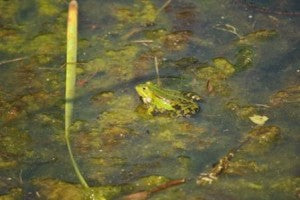Are you experiencing brown, murky water or unwanted pond weeds, such as algae? Don’t despair; these are common occurrences with most ponds at some point. Controlling the source of these water problems can help to keep your pond water at its optimum. Some common sources:
Leaves or other Debris
If leaves and other debris are allowed to enter your pond, decomposition will occur and carbon dioxide will be released into the water. In large quantities, this decomposition can cause tea-colored pond water, and even worse, rob your pond of oxygen, causing fish illness or death. In times of heavy leaf drop in the autumn, a pond net could be placed over the pond to help control this. Always be sure to remove any leaves that are on the bottom of your pond. To control the tea-colored water, activated carbon can be placed in a skimmer, biological filter or anywhere that there is good water movement.
Fish Load
Assuring your fish load is adequate for your pond size is important. The recommendation for proper fish population is 10” of fish for every 100 gallons. If you have more than this, you might consider finding a new home for some of your fish.
Fish Feeding
Overfeeding your fish can cause a breeding environment for algae and other water clarity issues. The recommendation for proper fish feeding is feed only water your fish can eat in 2-3 minutes. Quality fish food is equally important.
Pond Shading
Algae thrive on excessive sunlight, so having at least 50% of your pond’s surface shaded for about 6 hours a day is ideal for controlling algae blooms. The addition of pond plants can help shade, as well as, beautify your pond. Pond plants directly compete with algae for nutrients and sunlight. One such aquatic plant to consider, the water lily, has broad leaves which cover much surface area. Water hyacinth, known as an oxygenator, is another aquatic plant to consider. It is a floating plant and helps to replenish oxygen into the pond; which helps to control algae as well. It reproduces quite plentiful as well but is not hardy for colder winter climates.
Correct Pump Size
Your pump should be sized so that it can turn over the complete volume of water in 1 hour. So, if you have a 3500 gallon pond, you should have a 3500 GPH pump. Assure that the pump isn’t clogged or isn’t pumping above its specified head height. Always follow the pump manufacturer’s guidelines.
Reference: Aquascape



